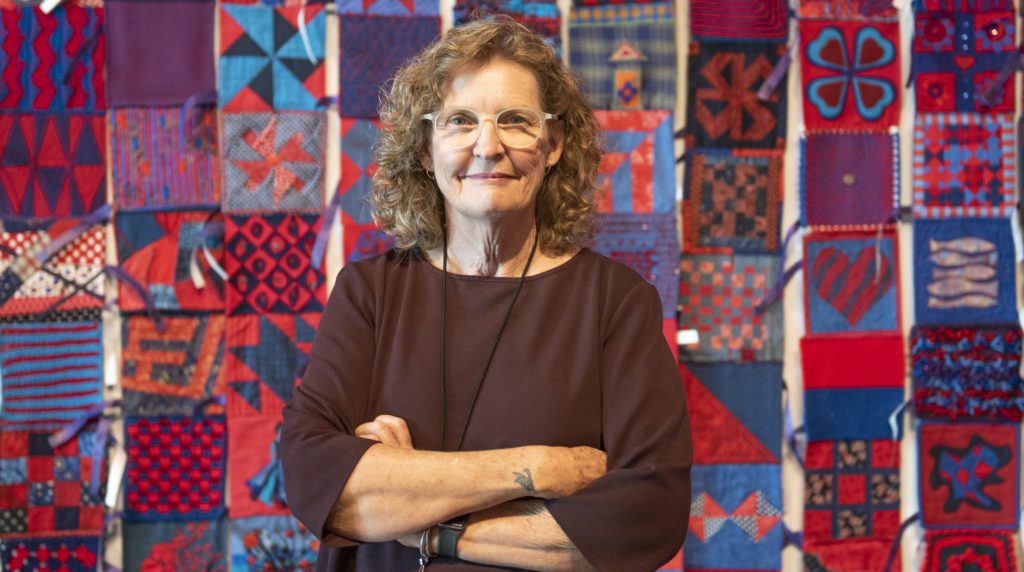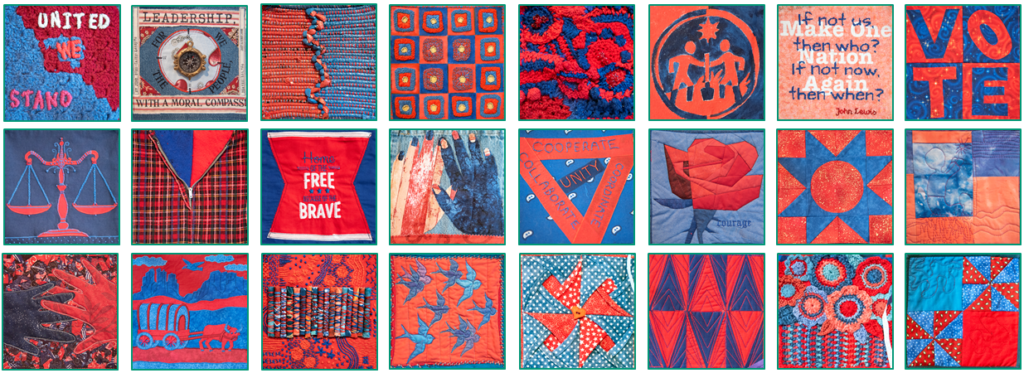
By Julie Anderson
Flinn Foundation
Ann Morton is a fabric artist by trade, weaving and sewing textiles to translate her vision through her work. With her latest project, “The Violet Protest,” she has woven a new thread into her repertoire: a community of thousands interested in changing the tone of political values.
With the project name and mission in place, “The Violet Protest,” currently on display at the Phoenix Art Museum, had the framework it needed to be born.
“I knew when this opportunity came, I wanted to do a public project with this concern over the lack of governance or ability to govern because our politics are so divided. [That] has really been weighing on me for many, many years,” Morton says.
The name, “The Violet Protest,” is steeped in meaning, referencing the colors traditionally attributed to the country’s two largest political parties.
“The red and the blue, and the fact that … violet is right between red and blue on the color wheel,” Morton says. “And I love the word violet because it’s one letter away from the word violent, so it’s kind of a play on words.”
Morton’s work will be the backdrop of the start of the Arizona Center for Civic Leadership at the Flinn Foundation’s Flinn-Brown Academy, where an Aug. 19 gathering of the latest cohort of Flinn-Brown Fellows will include an opportunity to hear from the artist herself.
After winning the Arlene and Morton Scult Award in 2019, which annually grants an Arizona artist a cash prize and opportunity to exhibit at the Phoenix Art Museum, Morton presented her idea to the museum in December 2019, with plans for the exhibition to open to the public in January 2020.
At the beginning of 2020, everything was seemingly in place, with a website developed for the project, and materials and documents ready to be sent out. But as Morton, as well as the rest of the world, would soon find out, the year was about to take a drastic turn. The COVID-19 pandemic had potential to put the future of the project in jeopardy.
But the collaborative nature built into “The Violet Protest” only helped the project thrive in a time of self-quarantine, giving access to collaborators that may not have been available before. Makers were asked to create 8-by-8-inch squares, combining equal parts red and blue.

“The very act of combining threads, sewing it together, mending, weaving together the red and blue, is a metaphor for what all of the makers in the project hope our politicians will take heed of,” Morton says. “We’re not about any political issue. We’re really about core values.”
Morton reports that to date, nearly 3,000 makers have pledged more than 17,000 squares to the project. Submissions are welcomed from all over North America, with the highest concentration of submissions coming from Arizona. Once the exhibition ends, the squares will be sent in packages of 25 to 50 to every member of the United States Senate and House of Representatives.
In addition to managing the community submissions to “The Violet Protest,” Morton can also be found at the exhibit twice a week, knitting pieces to support the quilt squares and offering patrons a unique chance to interface with the artist and her work.
“It’s been great. I mean, I’ve had lots of exhibits, but I haven’t been in the gallery as much as I have for this one … so the reaction has been pretty stunning. Several (visitors) have been in tears when they left (or) been in tears when they come up to talk to me. It’s really been surprising; quite amazing,” Morton says.
Some of those visitors included notable elected officials such as U.S. Rep. Greg Stanton and Phoenix Mayor Kate Gallego, who proclaimed April 13, 2021, “Violet Protest Day” in Phoenix.
A native Phoenician and fiber artist, Morton’s body of work takes a historically gendered craft and breathes new life into the medium, one that can take on many different forms.
“Typically, people think of sewing and weaving and knitting, and they think of, to be honest, women’s work, but it really can become quite sculptural. There’s quite a few men that use fiber aesthetics in their art,” Morton says. “Not to mention that fiber (art) has such a history of community; like quilting bees and knitting circles. It really fits into the whole idea of what I do in my practice.”
Over the course of her career, collaboration has been a keystone of Morton’s work. Morton describes her practice as “a combination of my own work and these large interventions where I call for work from a variety of different communities.”
Morton received her master’s degree in fine art with an emphasis in fibers from Arizona State University in 2012, after working as a graphic designer for 35 years.
Submissions are being accepted through early September. “Ann Morton: The Violet Protest” will be on display through Sept. 5 at the Phoenix Art Museum.